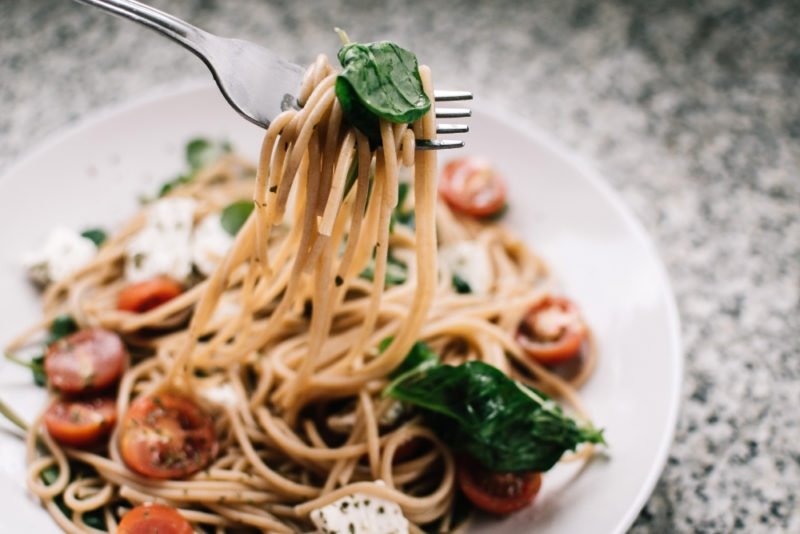
If you read my weekly column in The Seattle Times, you know that I occasionally create recipes. You may have also noticed that I never include “nutrition information” at the end of the recipe. Every time, at least one reader emails me asking for nutrition info. Almost always because they are counting calories or carbs.
My standard response goes something like this: “I choose not to include nutrition information with my recipes because I don’t encourage calorie counting, and for some people who struggle with disordered eating or eating disorders, it’s a relief to see a recipe that doesn’t include that information. All of my recipes are made from nutritious ingredients, but if knowing the calories is important to you, then there is no shortage of recipes that do include that info.”
Here’s the thing: when we meticulously track our calories in and calories out, then feel secure in the final tally, we’re really just kidding ourselves. Keeping a food record has some usefulness for understanding overall eating patterns or sleuthing out what’s causing symptoms that may be food related. But tracking calories via food-tracking apps? Research suggests we shouldn’t put too much faith in the numbers. For example:
- Your “medium apple” might not really be medium-sized.
- Calories listed in restaurant menus may be “good guesses” at best, in part because you might be served an amount that’s slightly more — or slightly less — than the portion size that was analyzed.
- For some foods, the number of calories listed on the food label or in nutrient databases may not be accurate.

Where do “calorie counts” even come from?
For more than 100 years, calorie counts have been based on the “Atwater factors.” This is a system developed in the 1890s by Wilbur Atwater, based on his experiments investigating how many calories we actually metabolize and absorb from food. That’s where the estimates of 4 calories per gram of protein and carbohydrates, and 9 calories per gram of fat came from. All of the calories on food labels are probably from Atwater factors.
It appears that the Atwater factors may not be as accurate as was once thought. Take nuts, for example. Several years ago, a few research studies re-evaluated how many calories our bodies extract from nuts. It turns out that almonds have 23 percent fewer absorbable calories than thought, walnuts have about 21 percent less and pistachios have 5 percent fewer calories. This has to do with the fact that nuts are from plants, and plant foods have cell walls that the body must break down in order to digest and absorb the fat and other nutrients inside.
Atwater also didn’t take into account that the effects of cooking and processing matter. Cooking lets us pull more calories from starches and proteins. This means we absorb more calories from peanut butter than we do from whole peanuts, more from well-done steak than rare steak.

More reasons why calories aren’t what they seem to be
Certainly, there is a sense of security in numbers. However, not only can we not gauge calorie counts with real accuracy, it’s increasingly difficult to be certain of what a calorie actually means to our bodies, for a few reasons:
- How do you know how many calories you really need? There are equations that give an estimate. If you use a tracker app, it likely uses the same equation. But people are not equations — they are complex and variable. So when you eat to meet a number goal, you may be widely missing the true mark of your calorie needs.
- How do you know how many calories you burn through movement? The calorie estimators on gym cardio equipment give notoriously (falsely) high numbers, but even your tracker app is just guessing based on your age, gender and weight. If the good feeling you have from checking exercise off your to-do list makes you decide you “deserve” a burger and fries, you’ve just out-eaten your exercise, and then some.
Calorie needs can differ by hundreds of calories even between two people of the same age, gender and weight — the three factors used to estimate calorie requirements. Why such differences? The gut microbiome is one likely reason, since the population of microbes in your intestines affects how many calories you pull from your food. Eating out of sync with your circadian rhythms (i.e., eating at night) also can affect how we metabolize food. Even how we chew makes a difference.
The bottom line is that counting calories is time-consuming and prone to errors — human or otherwise. For example: “My Fitbit said I had 200 more calories left, so I had an evening snack…no, I wasn’t actually hungry.” When you are trying to eat portions of food that are compatible with what your body needs, your efforts are better spent looking inward.

Looking inside for guidance
A better way to know what your body needs is to start paying attention to your body by building appetite awareness. Are you hungry? Satisfied? Too full? These questions are a key component of Intuitive Eating. Knowing how your body feels when it needs food and when it’s had enough food is easier if you are mindful. When you make eating decisions on autopilot or while distracted (or based solely on calories), you aren’t tuned in to what you and your body really need. Here are some questions you can ask yourself:
- When do you feel hungry?
- How much food does it take to feel satisfied (i.e., no longer hungry)?
- How much food does it take to feel full? How much food does it take to feel overfull?
- How do you feel when you eat a good amount of protein for breakfast (such as eggs or Greek yogurt) vs. when you eat toast, oatmeal or cereal?
- Do you need snacks between meals (i.e., you feel actual hunger) or do you simply want a snack between meals (i.e., you’re bored, or you’re operating on autopilot)?
- Does your food make you feel energized, or sleepy?
- What happens when you are absolutely starving at mealtime, vs. when you are just “normal hungry”?
- Do you eat for non-hunger reasons (stress/emotions/cravings)?
- Do you eat just because food’s there?
- Are most of your meals based on whole foods (single ingredient) or minimally processed foods (yogurt, tofu, quality bread are a few examples), or do you eat a lot of foods that come from boxes, bags and to-go containers?
Get a handle on the answers to these questions, and calories become almost irrelevant.
Carrie Dennett, MPH, RDN, is a Pacific Northwest-based registered dietitian nutritionist, journalist, intuitive eating counselor, author, and speaker. Her superpowers include busting nutrition myths and empowering women and men to feel better in their bodies and make food choices that support pleasure, nutrition and health. This post is for informational purposes only and does not constitute individualized nutrition or medical advice.
Seeking 1-on-1 nutrition counseling? Learn more about her Food & Body, IBS management, and nutrition counseling programs, and book an intro call to see if the program is a good fit, and if we’re a good fit!
Want exclusive content on nutrition, health, diet culture and more, plus critiques of nutrition and health journalism? Subscribe to my Food Noise newsletter! 📣






